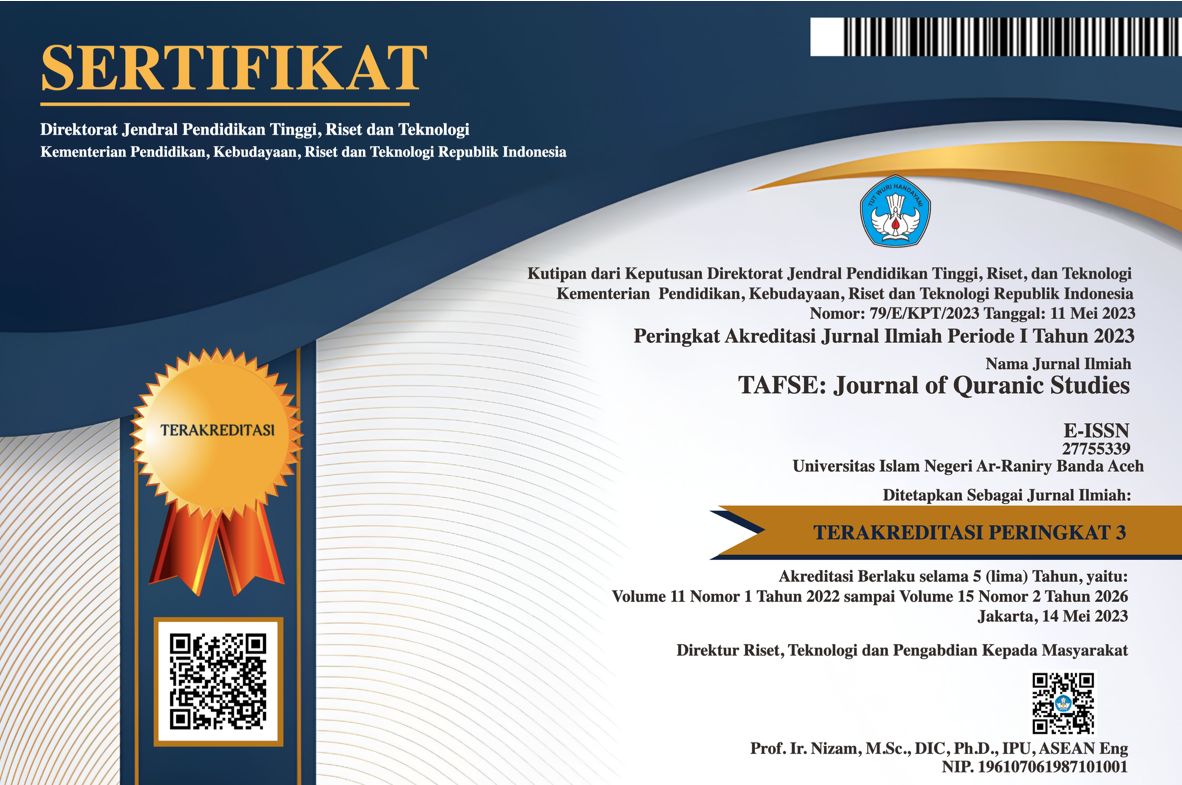Lafal Layta dalam Al-Qur’an
DOI:
https://doi.org/10.22373/tafse.v5i2.8549Keywords:
Layta, Tamannî, PenyesalanAbstract
This article is a research about the word of layta in the Qur’an. Generally, the use of the word of layta in the Qur'an referred to unbelievers when expressing their remorse in the afterlife. However, there are Qur'an verses that use the word of layta referred to the believers and in the context of the world. Due to the variations of this designation, the author feels the need for more in-depth research related to the use of the word of layta in the Qur'an. This research is library research, using content analysis techniques in processing data. The data sources that the authors refer to are Balâghah books such as al-Balâghat al-Wâdhihah, and the book of interpretation. The results of this study can be concluded that the word of layta is mentioned fourteen times in the Qur'an, with three speakers: believers, unbelievers, and hypocrites. The meanings indicated by this word are regret, delusion, and good wishes. Then, these meanings are connected with psychology. And the result is that if the pronunciation of this word relies on the believer, it shows a positive meaning, such as a sense of empathy. Conversely, if it relies on other than believers, it has a negative meaning.
Tulisan ini merupakan penelitian terhadap lafal layta yang terdapat dalam al-Qur’an. Umumnya, penggunaan lafal layta dalam al-Qur’an disandarkan kepada orang-orang kafir ketika mereka mengungkapkan penyesalannya di akhirat. Namun, ada ayat al-Qur’an yang menggunakan lafal layta dengan disandarkan kepada orang mukmin dan dalam konteks dunia. Berangkat dari adanya variasi penyandaran lafal tersebut, penulis merasa perlu meneliti lebih dalam terkait penggunaan lafal layta di dalam al-Qur’an. Penelitian ini bersifat kepustakaan (library research), dengan menggunakan teknik analisa isi (content analysis) dalam mengolah data. Sumber data yang penulis rujuk adalah kitab-kitab Balâghah seperti al-Balâghat al-Wâdhihah dan kitab-kitab tafsir. Hasil dari penelitian ini dapat disimpulkan bahwa lafal layta disebut sebanyak empat belas kali dalam al-Qur’an, yang disandarkan kepada tiga subjek, yaitu mukmin, kafir dan munafik. Makna yang ditunjukkan lafal layta adalah penyesalan, angan-angan dan harapan yang baik. Selanjutnya, makna-makna tersebut dihubungkan dengan ilmu psikologi. Maka, hasil yang didapatkan adalah jika pengucapan lafal ini disandarkan kepada orang mukmin, ia menunjukkan makna positif, seperti rasa empati. Sebaliknya, jika disandarkan kepada selain mukmin, maka ia bermakna negatif.
Downloads
References
Al-Ja‘îd, Ibrâhîm ‘Ali. Khashâish Binâ’ Al-Jumlat Al-Qur’âniyyah Wa Dalâlâtuhâ Al-Balâghiyyah Fî Tafsîr Al-Tahrîr Wa Al-Tanwîr. Mekkah: Universitas Umm al-Qurâ, 1999.
Al-Murâdî, al-Hasan Ibn Qâsim. Al-Janâ Al-Dânî Fî Hurûf Al-Ma‘Ânî. Beirut: Dâr al-Kutub al-‘Ilmiyyah, 1992.
Al-Qur’an, Lajnah Pentashihan Mushaf. Keniscayaan Hari Akhir (Tafsir Al-Qur’an Tematik). Jakarta: Aku Bisa, 2015.
Al-Qurthubî. Tafsîr Al-Qurthubî, Terj. M. Masridha, Jilid 5. Jakarta: Pustaka Azzam, 2008.
Al-Râzî, Fakhr al-Dîn. Mafâtîh Al-Ghayb, Jilid 21. Beirut: Dar al-Fikr, 1981.
Al-Sayyid, Ismâ‘îl Ahmad ‘Umâyrah dan ‘Abd al-Hamîd Mushthafâ. Mu‘Jam Al-Adawât Wa Al-Dhamâir Fî Al-Qur’Ân Al-Karîm. Beirut: Muassasah al-Risâlah, 1986.
Al-Suyûthî, Jalâl al-Dîn. Asbâb Al-Nuzûl, Terj. Muhammad Miftahul Huda. Sola: Insan Kamil, 2016.
———. Studi Al-Qur’an Komprehensif, Terj. Tim Editor Indiva. Surakarta: Indiva Pustaka, 2008.
Al-Zuhaylî, Wahbah. Tafsîr Al-Munîr, Terj. Abdul Hayyie Al-Kattani, Jilid 8. Jakarta: Gema Insani, 2016.
Amîn, Alî al-Jârim dan Musthafâ. Al-Balâghat Al-Wâdhihah, Terj. Mujiyo Nurkholis. Bandung: Sinar Baru Algensindo, 1993.
Bachmid, Ahmad. Dars Al-Balâghat Al-‘Arabiyyah: Al-Madkhal Fî ‘Ilm Al-Balâghah Wa ‘Ilm Al-Ma‘Ânî. Jakarta: PT. Raja Grafindo Persada, 1996.
Dumilah, Retno. “Ungkapan Lafal Al-Rajâʼ Dan Al-Tamannî Dalam Al-Qur’ân.” Universitas Islam Negeri Ar-Raniry Banda Aceh, 2018.
Faraz. “Teori Penyesalan Perspektif Barat Dan Islam.” Jurnal Psikologi Islam 4, no. 2 (2017): 237.
Jalaluddin. Psikologi Agama. Jakarta: PT. Raja Grafindo Persada, 2004.
Jess Fess, Dkk. Teori Kepribadian, Terj. R.A. Hadwitia Dewi Pertiwi. Jakarta: Salemba Humanika, 2018.
Mujib, Abdul. Kepribadian Dalam Psikologi Islam. Jakarta: PT. Raja Grafindo Persada, 2006.
Rohmah, Umi Nuriyatur. “Gaya Bahasa Do’a Dalam Al-Qur’an Dan Hadis.” Universitas Islam Negeri SUnan Kalijaga Yokyakarta, 2016.
Said Agil Husin Al Munawwar, Masykur Hakim. I‘Jaz Al-Qur’an Dan Metodologi Tafsir. Semarang: Dina Utama, 1994.
Shihab, M. Quraish. Ensiklopedia Al-Qur’an: Kajian Kosakata, Jilid 2. Jakarta: Lentera Hati, 2007.
———. Tafsir Al-Mishbah: Pesan, Kesan Dan Keserasian Al-Qur’an, Jilid 12, Cet. 7. Jakarta: Lentera Hati, 2002.
UI, Tim Penulis Fakultas Psikologi. Psikologi Sosial. 2nd ed. Jakarta: Salemba Humanika, 2018.
Downloads
Published
Issue
Section
License
Authors who publish with this journal agree to the following terms:
- Authors retain copyright and grant the journal right of first publication with the work simultaneously licensed under a Creative Commons Attribution License (CC BY NC 4.0) that allows others to share the work with an acknowledgment of the work's authorship and initial publication in this journal.
- Authors are able to enter into separate, additional contractual arrangements for the non-exclusive distribution of the journal's published version of the work (e.g., post it to an institutional repository or publish it in a book), with an acknowledgment of its initial publication in this journal.
- Authors are permitted and encouraged to post their work online (e.g., in institutional repositories or on their website) prior to and during the submission process, as it can lead to productive exchanges, as well as earlier and greater citation of published work (See The Effect of Open Access).





